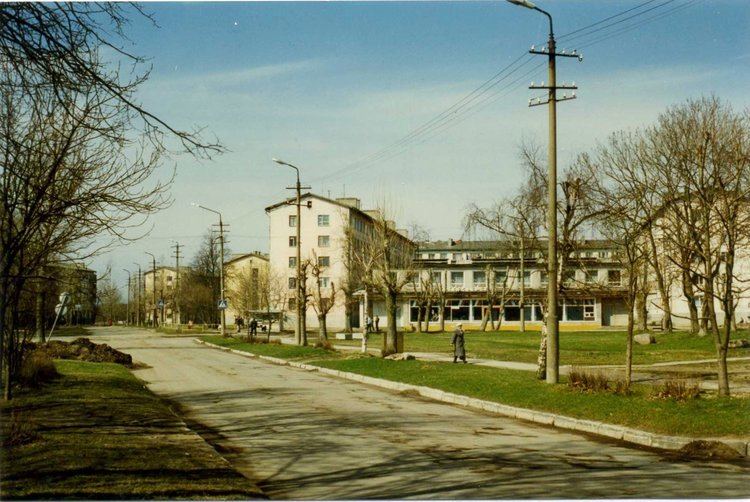City rights 1783 Website www.paldiski.ee Population 3,767 (Jan 2016) | Time zone EET (UTC+2) Area 60.17 km² Local time Tuesday 9:05 AM | |
 | ||
Weather 3°C, Wind SE at 14 km/h, 96% Humidity Points of interest Amandus Adamson Studio M, Pakri Islands, Amandus Adamsoni mälestussammas, Pakri Straus | ||
Paldiski is a town and Baltic Sea port situated on the Pakri peninsula of north-western Estonia. Originally a Swedish settlement known as Rågervik, it became a Russian naval base in the 18th century. The Russians renamed it Балтийский Порт ("Baltiyskiy Port", i.e. Baltic Port, German: Baltisch-Port) in 1762. In Estonian the name was spelled Baltiski until 1933 when the Estonian pronunciation Paldiski became the official name.
Contents
- Map of Paldiski Harju County Estonia
- Russian Empire
- Soviet era
- After Estonia regaining independence
- Today
- Education and community
- Transport
- Energy
- In the media
- Notable people
- References
Map of Paldiski, Harju County, Estonia
Russian Empire
On 23 June 1912 the Russian emperor Nikolai II and German kaiser Wilhelm II met for the last time before World War I in Paldiski.
Soviet era
In 1962, Paldiski became a Soviet Navy nuclear submarine training centre. Employing some 16,000 people, and with two land-based nuclear reactors (at 70 MW and 90 MW power, respectively), it was the largest such facility in the Soviet Union. Because of its importance, the whole city was closed off with barbed wire until the last Russian warship left in August 1994, when the city ceased to be a closed city. This followed the events of 1991, when the Soviet Union collapsed and Estonia regained independence. To house the stationing troops and those in training, many barracks buildings were built, which have since been left in disrepair. Russia relinquished control of reactor facilities in September 1995; the nuclear reactors were shut down, and nuclear material was transported back to Russia. The reactors were thereafter decommissioned.
After Estonia regaining independence
After Estonia restored its independence, the city had not enough Estonian citizens, and Paldiski was then subordinated to Keila until 30 October 1996. Located some 45 km west of Tallinn, Paldiski is since then a municipality within Harju County. Derelict Soviet-style apartment buildings made up much of the town, and the relics of military bases are widespread. The majority of the town's residents are ethnic Russians. The ferry company Tallink operated a regular connection with Kapellskär in Sweden; the line is currently served by another operator.
Today
Until recently, the amenities were limited to a single, small hotel (Valge Laev, with six guest bedrooms and a restaurant/bar). Now there are also two grocery stores, an alcohol store, a bank, a tavern, and a bed & breakfast. The renovated train station also has a small cafe with hot food.
The housing blocks in the town no longer appear dilapidated and abandoned and have been refitted and re-painted in recent years. There are also several new apartment buildings, and the green areas along with children's parks have been restored.
The Scouts Single Infantry Battalion, Kalevi Infantry Battalion and the Combat Service Support Battalion of Estonia, which belong to the 1st Infantry Brigade (Estonia) of the Estonian Defence Forces are stationed in Paldsiki.
Education and community
Paldiski has two schools: Paldiski Gümnaasium and Vene Gümnaasium (Russian Gymnasium).
In addition, there is a private pre-school facility, called Paladski Beebi Maja.
There are several churches in town. The Estonian Evangelical Lutheran Church is dedicated to St Nicholas. Although closed for some years, this church has now reopened, with services held every Sunday at lunchtime. There are also a Pentecostal church, a Methodist church, and an Orthodox church.
Transport
Paldiski has a terminus station on the Elron rail line, providing a convenient link to the capital city. As part of the town's redevelopment, this once near-derelict station has been renovated and painted in bright yellow and white colours.
A great deal of investment has been put into the two ports and their facilities with a number of new berths having been created. From Paldiski Southern Port, Transfennica runs a number of ships to the port from Hanko (Finland) and Lübeck (Germany). From Paldiski Northern Port, DFDS runs a six-roundtrip operation to Kapellskär (Sweden) for passengers, and a Cargo and Navirail operation to and from Hanko (Finland).
The old Soviet 'Pentagon' building has been demolished at some point between 2006 and 2009 to make way for a large and modern logistics park.
Energy
The Pakri wind farm is located in Paldiski at the tip of the Pakri peninsula near the old light house. It consists of eight wind turbines of type Nordex N-90, and generates 18.4 MW of clean electricity, when the wind matches the parametres of the turbines.
Construction of a receiving LNG terminal near the town is considered.
In the media
The 2002 film Lilya 4-ever, set in an unnamed "former republic of the Soviet Union", was largely filmed in Paldiski.
The 2015 music video for Alan Walker's popular song "Faded" was in part filmed around or near Paldiski.
